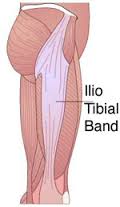 The IT-band (or iliotibial band) runs from the top of the pelvis, or ilium, and extends all the way down the outside of the thigh to the top of the lower leg, or tibia. In the thigh, it also connects to your glutes and tensor fascia latae muscles, and as it travels downward, has fibers that blend into your knee cap as well. The IT-band is made up of very dense connective tissue, making it extremely strong to provide stability during weight bearing activity. Functionally speaking, when we bend and straighten our knee repetitively (i.e. during running), the band slides back and forth and can sometimes cause localized irritation or inflammation. This can result in a very common sports related injury called IT-band syndrome. Symptoms can be felt anywhere along the IT-band, but usually occur closer to the attachment near the lateral knee. Muscle imbalances, like tight hip flexors or weak hip rotators, can often times be the cause of developing IT-band syndrome.
The IT-band (or iliotibial band) runs from the top of the pelvis, or ilium, and extends all the way down the outside of the thigh to the top of the lower leg, or tibia. In the thigh, it also connects to your glutes and tensor fascia latae muscles, and as it travels downward, has fibers that blend into your knee cap as well. The IT-band is made up of very dense connective tissue, making it extremely strong to provide stability during weight bearing activity. Functionally speaking, when we bend and straighten our knee repetitively (i.e. during running), the band slides back and forth and can sometimes cause localized irritation or inflammation. This can result in a very common sports related injury called IT-band syndrome. Symptoms can be felt anywhere along the IT-band, but usually occur closer to the attachment near the lateral knee. Muscle imbalances, like tight hip flexors or weak hip rotators, can often times be the cause of developing IT-band syndrome.
So what are the best ways to treat IT-band syndrome?
First, make sure to address any muscle imbalances by getting into a regular stretching and strengthening routine. A physical therapist can help identify specifically which muscle groups you should address to improve overall mobility and stability. Make sure you address the overall mobility of the IT-band as well by using products like a foam roller or massage stick. These products can be used regularly to help treat and prevent further irritation.
Secondly, make sure you have proper footwear. A lack of proper support in your foot can affect the forces in in your knee and hip and contribute to muscle imbalances related to IT-band syndrome.
Finally, make sure you get into a routine of regularly icing the affected area for 15-20 minutes to treat any localized inflammation.

